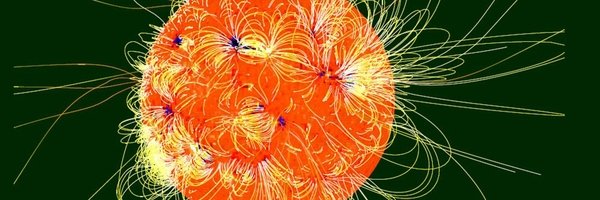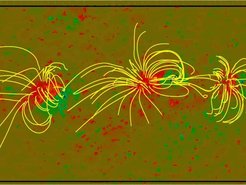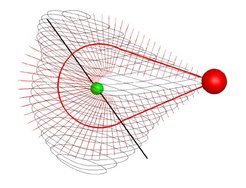
Stereoscopy and magnetic field reconstruction
Nonlinear force-free coronal magnetic field models
The solar corona is dominated and structured by the magnetic field. In lowest order we can neglect all non-magnetic forces and model the solar corona with a force-free model. Force-free means that the Lorentz-force vanishes. This is equivalent to the assumption that the electric current density and magnetic field vector are parallel. In the generic case the relation between current density and magnetic field is not linear and sophisticated numerical codes are required to compute the nonlinear force-free coronal magnetic field model. As input the model requires measurements of the photospheric magnetic field vector (e.g. from SDO/HMI, Hinode/SOT, SUNRISE/IMAX).

The figure shows a nonlinear force-free coronal magnetic field model (yellow lines) for 3 connected active regions. Shown in red (positive) and green (negative) is the vertical photospheric magnetic field.
When magnetic flux emerges from below the solar surface and expands into the corona, the coronal magnetic field is destabilized, leading to large-scale explosive phenomena, such as coronal mass ejections and flares. The magnetic energy available to be released during these events is believed to be stored in current-carrying magnetic fields which can be reconstructed and monitored in time with the nonlinear force-free extrapolation code. Furthermore the reconstructed 3D models guide also the analysis of the coronal plasma, as observed in EUV-images (e.g. from STEREO/EUVI, SDO/AIA, SOHO/EIT/SUMER) and allow to get insights regarding coronal heating and solar wind acceleration.
Stereoscopy and Tomography of coronal plasma structures
The aim of these endeavors is the reconstruction of the 3D shapes of coronal loops, polar plumes, coronal mass ejections and eruptive prominences. The possibility of stereoscopic EUV observations of the solar corona opened 2006 with the launch of the twin STEREO spacecraft, which are continuously drifting away from Earth in different directions by about 20 degrees/year. Meanwhile, we also integrate observations from a third viewpoint (SoHO or SDO, in future Solar Orbiter) or other information like coronal magnetic field models. In order to extract the relevant information from EUV images we use image-processing schemes (e.g., ridge detection, Hough transforms) which detect small-scale, high-contrast features. More diffuse objects like CME clouds are reconstructed by detecting the density contrast to the surrounding low density corona. Diffuse stationary structures like the coronal streamer belt can also be assessed by tomography making use of the solar rotation.

The figure shows the reconstruction of a CME cloud a few hours after its release. The ball in the centre denotes the geometrical barycentre, the heavy line its major axis of inertia, the thin curves represent cross sections of the cloud's outline.
Many of these density structures are shaped by the coronal magnetic field. In a more recent approach, we therefore try to combine the magnetic field extrapolation and the stereoscopic reconstruction.
Coronal heating
The solar surface has a temperature of about 6000 K, but the solar corona is several orders of magnitude hotter with 1 MK and more. Heat conduction cannot be responsible for this phenomenon as the environment (corona) can’t become hotter than the source (solar surface).
However, the density of the coronal plasma is also orders of magnitudes lower than in the photosphere. This means that mechanic energy sources, for example turbulent motion in the photosphere, are fully sufficient to heat the faint coronal plasma. The coronal heating problem is strongly related to studying the magnetic connectivity between photosphere, chromosphere, transition region and corona and requires a combination of sophisticated numerical models, high resolution photospheric magnetic field measurements (e.g. from Sunrise/IMaX) and images/spectroscopic measurements of different layers (chromosphere, transition region corona) of the solar atmosphere (e.g. from SOHO/SUMER and in future IRIS).













